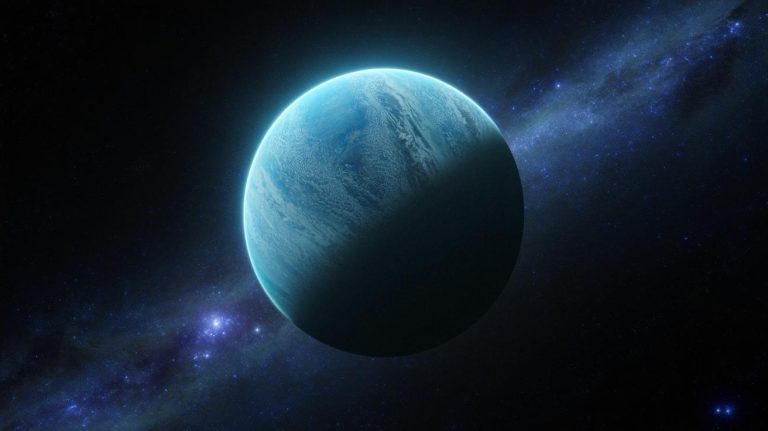| IN A NUTSHELL |
|
In the vastness of our solar system, the quest for discovering new celestial bodies continues to capture the imagination of astronomers and space enthusiasts alike. Among these mysteries is the elusive Planet Nine, a hypothetical giant that could be hiding in the shadowy realms beyond Neptune. Recent studies have unearthed tantalizing clues, suggesting that this enigmatic planet might indeed exist, potentially reshaping our understanding of the solar system’s architecture. As scientists delve deeper into this cosmic puzzle, the boundaries of what we know about our celestial neighborhood are being continually tested and expanded.
Unraveling the Mystery of Planet Nine
Planet Nine has been a topic of intrigue since the reclassification of Pluto in 2006. This demotion left our solar system with eight recognized planets, sparking debates and speculations about the existence of another distant giant. The hunt for Planet Nine is not merely a quest to add another name to the planetary roster but a scientific endeavor to explain the peculiar gravitational effects observed in the Kuiper Belt. These effects suggest the presence of a massive, unseen body influencing the orbits of smaller objects.
The recent breakthrough involves the comparison of infrared surveys taken decades apart. This analysis has identified a potential candidate for Planet Nine, a celestial body exhibiting the expected slow motion characteristic of a planet orbiting far from the sun. The discovery is a testament to the power of modern astronomical techniques, combining historical data with current technology to unravel the universe’s mysteries. If confirmed, Planet Nine could be five to ten times the size of Earth, with an orbit unlike any known planet in our solar system.
Comparing the Two Sky Surveys
In a groundbreaking approach, researchers have revisited data from NASA’s Infrared Astronomical Satellite (IRAS) and Japan’s AKARI satellite, separated by a span of 23 years. British astronomer Michael Rowan-Robinson initially spotted a potential Planet Nine candidate in 1983. However, it was not visible in subsequent datasets, leaving its status unconfirmed. The recent study led by Patrick Phan took a novel approach by comparing IRAS and AKARI data, revealing an object that shifted position consistent with planetary movement.
This discovery is significant as it represents the first potential sighting of Planet Nine in two distinct datasets, reinforcing its credibility. The estimated mass of this candidate suggests it could be more massive than Neptune. Its suspected orbit, swinging between 280 AU to 1,120 AU from the sun, highlights a unique trajectory through the solar system. Such a distant and eccentric orbit raises intriguing questions about the planet’s origin and evolution, challenging current models of planetary formation.
A Piece of Evidence, but Not Proof
The excitement surrounding the potential discovery of Planet Nine is tempered by the need for further evidence. While the recent findings suggest a likely candidate, they are not definitive proof of its existence. The scientific community remains cautious, acknowledging that indirect evidence, such as gravitational influences and infrared detections, must be corroborated with more direct observations.
The verification of Planet Nine would mark a historic moment in astronomy, being the first planet discovered through indirect observation in modern times. This achievement would not only expand our planetary roster but also provide insights into the solar system’s dynamics. The research team is optimistic that future telescopic advancements and observational studies will confirm their findings, offering a clearer picture of our cosmic backyard.
The Future of Planetary Discovery
The search for Planet Nine exemplifies the evolving nature of astronomical research. As technology advances, scientists are equipped with tools and methods previously unimaginable, enabling them to explore the universe’s hidden corners. The potential discovery of a ninth planet underscores the importance of revisiting historical data with fresh perspectives and innovative techniques.
While NASA’s recent WISE surveys have yet to detect this elusive planet, researchers remain undeterred. The dynamic nature of celestial bodies means that Planet Nine’s current position is uncertain, necessitating ongoing observation and analysis. The study’s imminent publication in the journal Publications of the Astronomical Society of Australia will likely spur further interest and investigation, potentially paving the way for new discoveries in the years to come.
The quest to uncover Planet Nine is a reminder of the vastness and complexity of our solar system. As scientists continue to piece together the cosmic puzzle, they are driven by a fundamental curiosity about the universe and our place within it. Could the confirmation of Planet Nine redefine our understanding of the solar system, and what other mysteries might lie in the uncharted depths of space?
Did you like it? 4.3/5 (21)








Wow, a new planet candidate? This is seriously exciting stuff! 🌌
How can we be sure it’s not just a big asteroid or something? 🤔
Great article! I love learning about the mysteries of our solar system. Thanks for sharing!
So, when can we expect to get more concrete evidence about this Planet Nine? ⏳
Is this the same as the “Nibiru” conspiracy I’ve heard about, or is it different?
Fascinating read, but I’m skeptical until I see more solid proof.
Did they really spot it 700 times farther than Earth, or was that a typo? 😅